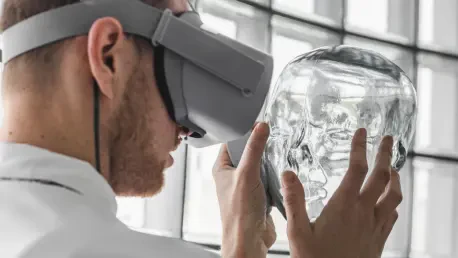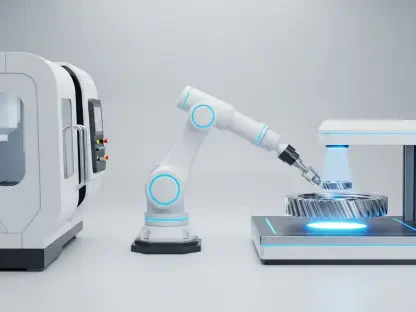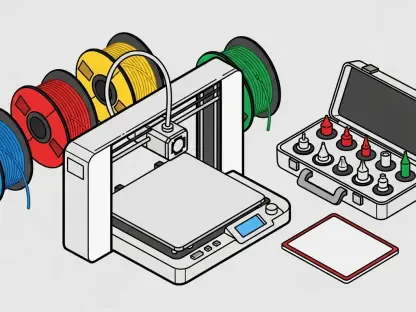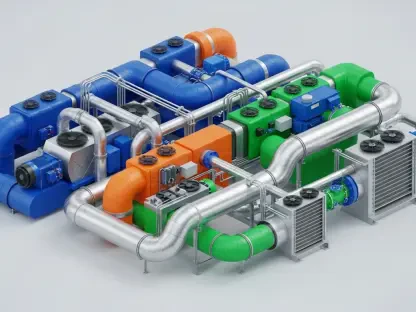In a world where durability and sustainability are becoming paramount, the self-repair material market is emerging as a transformative force in material science and engineering. These cutting-edge materials, often dubbed self-healing materials, possess the remarkable ability to autonomously mend damage such as cracks or wear without any human intervention. This unique property not only enhances the lifespan of products but also slashes maintenance costs, making a significant contribution to eco-friendly practices across a wide array of industries. Valued at approximately $1.14 billion in 2023, this market is on a trajectory to reach an impressive $2.5 billion by 2032, driven by a robust compound annual growth rate (CAGR) of 9.16% from 2025 onward. Such growth signals a rising demand for innovative solutions that address both economic and environmental challenges in today’s industrial landscape. The potential of self-repair materials to revolutionize sectors ranging from construction to healthcare is capturing global attention, setting the stage for a future where durability is no longer a luxury but a standard.
The implications of this technology are vast and varied, touching on everything from towering skyscrapers to intricate medical devices. Imagine concrete that repairs its own fissures over time or aircraft components that heal minor damages during flight—scenarios that are shifting from mere imagination to tangible reality. This market’s expansion is fueled by a collective push for sustainable practices, as industries seek ways to reduce waste and extend product life cycles. The ability of self-healing materials to adapt and recover autonomously positions them as a cornerstone of innovation, promising not just cost savings but also a significant reduction in environmental impact. As global industries grapple with the dual demands of performance and sustainability, the adoption of these materials is becoming a strategic imperative, reshaping how products are designed, manufactured, and maintained.
Market Growth and Economic Impact
Key Growth Projections
The financial outlook for the self-repair material market is nothing short of striking, with projections indicating a climb to $2.5 billion by 2032. This growth is underpinned by a steady CAGR of 9.16% starting from 2025, reflecting sustained and accelerating demand across multiple sectors. Such figures underscore the economic significance of self-healing materials as industries recognize their potential to transform operational efficiencies. The construction sector, for instance, sees these materials as a way to build longer-lasting infrastructure, while aerospace and automotive industries value their capacity to enhance safety and reduce downtime. This upward trajectory is not just a number but a testament to the growing trust in technologies that prioritize resilience and longevity, marking a shift in how value is perceived in industrial applications.
Beyond the headline numbers, this growth signals a deeper shift in market dynamics. The projected expansion to $2.5 billion highlights how self-repair materials are becoming integral to high-stakes industries where reliability is non-negotiable. The consistent CAGR points to a maturing market that is moving beyond experimental phases into mainstream adoption. Economic analyses suggest that this trend will likely spur job creation in research, manufacturing, and application development, further embedding these materials into the global economy. As investment continues to flow into material science, the financial ripple effects are expected to benefit not just large corporations but also smaller innovators, fostering a competitive landscape that drives further advancements.
Industry-Wide Benefits
One of the most compelling advantages of self-repair materials lies in their cost-effectiveness, offering substantial savings on maintenance and replacement expenses. In industries like aerospace, where downtime can cost millions, the ability of materials to self-heal minor damages translates into significant operational efficiencies. Similarly, in construction, self-repairing concrete and coatings reduce the need for frequent repairs, extending the life of structures while lowering long-term costs. This financial benefit is a key driver behind the market’s rapid adoption, as companies across sectors seek ways to optimize budgets without compromising on quality or safety, making self-healing materials a strategic asset in cost management.
Durability is another critical benefit that self-repair materials bring to the table, redefining performance standards across industries. In the automotive sector, components that can autonomously mend wear and tear contribute to safer, more reliable vehicles, enhancing consumer trust. Electronics manufacturers are also tapping into this technology to create devices that withstand daily stresses, meeting growing demands for longevity in consumer products. This focus on durability not only boosts product lifespans but also aligns with sustainability goals by curbing the frequency of replacements, thereby reducing waste. As industries continue to prioritize resilient solutions, self-repair materials are poised to become a benchmark for innovation and efficiency.
Challenges and Opportunities
Barriers to Adoption
High production costs remain a significant obstacle in the widespread adoption of self-repair materials, often limiting their accessibility to well-funded industries or regions. The intricate processes involved in developing these materials, which frequently rely on advanced nanotechnology and polymer chemistry, drive up expenses, making them less viable for smaller enterprises or cost-sensitive markets. This financial barrier slows down the pace of integration, particularly in developing economies where budget constraints are a pressing concern. Until manufacturing techniques become more streamlined or economies of scale are achieved, the challenge of affordability will continue to hinder the market’s full potential, necessitating targeted solutions to democratize access.
Another hurdle lies in the limited awareness of self-healing materials’ benefits, especially in less industrialized regions. Many potential users remain unfamiliar with how these materials can revolutionize maintenance practices, resulting in slower uptake outside of tech-savvy markets like North America and Europe. Educational initiatives and marketing efforts are needed to bridge this knowledge gap, as lack of understanding often translates into reluctance to invest. Additionally, skepticism about the reliability of self-repair mechanisms in real-world scenarios further compounds this issue, emphasizing the need for robust demonstration projects to build confidence among stakeholders.
Technical limitations also pose a challenge, as the speed and effectiveness of self-healing processes often fall short under extreme conditions. Materials used in high-stress environments, such as aerospace or industrial machinery, may not recover quickly enough to prevent further damage, reducing their practical utility. Harsh temperatures, intense pressures, or chemical exposures can also impair healing capabilities, limiting applications in certain sectors. Addressing these shortcomings requires sustained innovation to enhance material resilience and adaptability, ensuring that self-repair technologies meet the rigorous demands of diverse industrial settings without compromising on performance.
Pathways for Growth
Investments in research and development (R&D) stand as a cornerstone for overcoming the current limitations of self-repair materials, paving the way for more affordable and effective solutions. Significant funding is being channeled into exploring new compositions and manufacturing methods that reduce costs while improving healing efficiency. Collaborations between academic institutions and industry leaders are accelerating breakthroughs in material science, leading to innovations that promise faster recovery times and greater durability. These R&D efforts are crucial for scaling production and making self-healing materials a feasible option across a broader spectrum of applications, ensuring that cost barriers gradually diminish as technology advances.
Emerging markets in regions like South America and the Middle East & Africa present untapped opportunities for market expansion, fueled by rapid industrial and infrastructural growth. As these areas invest heavily in construction and manufacturing, the demand for durable, low-maintenance materials is on the rise, creating a fertile ground for self-repair technologies. Governments and private sectors in these regions are increasingly prioritizing sustainable solutions, aligning with the benefits that self-healing materials offer. Tapping into these markets requires tailored strategies to address local needs and economic conditions, but the potential for growth is substantial, offering a pathway to diversify and strengthen the global presence of this innovative sector.
Partnerships between industries and research bodies are also proving instrumental in bridging the gap between laboratory advancements and real-world applications. These collaborations facilitate the testing and refinement of self-repair materials under practical conditions, ensuring they meet industry-specific standards. Joint ventures often lead to customized solutions, such as materials designed for specific environmental challenges or performance criteria, enhancing their market fit. By fostering a synergy between theoretical innovation and applied technology, such alliances are speeding up commercialization, making self-healing materials not just a futuristic concept but a present-day reality for industries worldwide.
Regional Dynamics and Applications
Leading and Emerging Regions
North America continues to dominate the self-repair material market, driven by its technological prowess and substantial investment in material science research. The region’s advanced infrastructure and focus on innovation have positioned it as a hub for developing and adopting self-healing technologies, particularly in high-value sectors like aerospace and electronics. Strong governmental support for sustainable practices further bolsters market growth, as policies encourage the integration of eco-friendly materials into industrial processes. This leadership is likely to persist as North American companies and institutions push the boundaries of what self-repair materials can achieve, setting benchmarks for global standards.
Europe follows closely, propelled by stringent sustainability regulations and a cultural emphasis on reducing environmental impact. The region’s commitment to green initiatives drives demand for self-healing materials in construction and automotive industries, where durability translates into lower carbon footprints. European nations are also home to numerous research initiatives focused on bio-inspired materials, enhancing the effectiveness of self-repair mechanisms. This focus on ecological responsibility, combined with robust funding for innovation, ensures that Europe remains a key player in shaping the market’s trajectory, influencing global trends toward sustainability.
Asia Pacific emerges as the fastest-growing region, fueled by rapid industrialization and large-scale infrastructure projects in countries like China and India. The surge in construction and manufacturing activities creates a pressing need for durable materials that can withstand heavy usage, making self-repair technologies highly attractive. Government-backed initiatives to modernize infrastructure further amplify demand, positioning the region as a critical growth engine for the market. As Asia Pacific continues to urbanize and industrialize at a staggering pace, its role in driving the adoption of self-healing materials will likely expand, reshaping the global landscape of this innovative sector.
Transformative Industry Applications
The impact of self-repair materials across industries is profound, with construction benefiting immensely from technologies that enhance structural longevity. Self-healing concrete, for instance, autonomously repairs cracks caused by environmental stress, reducing the need for costly interventions and extending the lifespan of buildings and bridges. This application not only cuts maintenance expenses but also improves safety by preventing structural failures, making it a game-changer for urban development. As cities worldwide grapple with aging infrastructure, the adoption of such materials offers a sustainable solution, ensuring that public and private projects remain viable for decades.
In aerospace and automotive sectors, self-repair materials are revolutionizing safety and reliability standards by addressing minor damages before they escalate into major issues. Components that can heal small cracks or abrasions during operation help prevent catastrophic failures, a critical advantage in high-stakes environments. This technology reduces downtime for repairs, translating into significant cost savings for manufacturers and operators while enhancing user confidence. The ability to maintain performance under stress is particularly valuable in these industries, where precision and durability are paramount, positioning self-healing materials as a vital innovation for future advancements.
The healthcare and electronics sectors are also witnessing transformative changes due to self-repair materials, particularly in improving device longevity and functionality. Medical implants that can mend minor wear over time offer better outcomes for patients, reducing the need for replacement surgeries. Similarly, electronic devices with self-healing components withstand daily wear, meeting consumer demands for durable products. These applications highlight the versatility of self-repair technologies, addressing niche yet critical needs in specialized fields. As these sectors continue to evolve, the integration of self-healing materials is expected to redefine standards of performance, pushing the boundaries of what is possible in both medical and technological arenas.
Future Horizons and Strategic Insights
Innovations on the Horizon
Looking ahead, the self-repair material market is set to benefit from groundbreaking innovations that address existing limitations and open new frontiers. Advances in nanotechnology and bio-inspired designs are expected to yield materials with faster healing times and greater resistance to extreme conditions, broadening their applicability. Research efforts are also focusing on integrating smart technologies, such as sensors that trigger self-repair mechanisms on demand, enhancing precision and efficiency. These developments promise to make self-healing materials a staple in industries that demand high performance, ensuring that the market remains dynamic and responsive to emerging needs over the coming years.
Sustainability will continue to drive innovation, with a focus on developing self-repair materials that are not only effective but also environmentally benign. Efforts to reduce the carbon footprint of production processes are gaining traction, as industries seek materials that align with global green standards. The potential for biodegradable self-healing materials is also under exploration, offering a future where durability does not come at the expense of ecological impact. Such advancements will likely attract further investment, reinforcing the market’s growth trajectory while addressing pressing environmental challenges that industries face today.
Strategic Steps Forward
Reflecting on the journey so far, the self-repair material market has achieved remarkable strides by overcoming initial skepticism and technical barriers through persistent research and industry collaboration. The valuation growth from earlier figures to the projected $2.5 billion by 2032 mirrors a broader acceptance of self-healing technologies as viable solutions across sectors. Stakeholders have recognized the dual benefits of cost savings and sustainability, which have fueled adoption in diverse applications from infrastructure to medical devices. This period of expansion has been marked by a collective effort to refine material capabilities, ensuring they meet real-world demands with increasing reliability.
Moving forward, strategic partnerships must be prioritized to accelerate the commercialization of advanced self-repair materials, building on past successes. Industries should focus on scaling up pilot projects that demonstrate the efficacy of these materials in varied conditions, fostering trust among end-users. Simultaneously, policymakers could play a pivotal role by incentivizing sustainable material adoption through grants or regulatory frameworks, mirroring earlier efforts that catalyzed market growth. By aligning innovation with practical implementation, the market can solidify its position as a cornerstone of future industrial and environmental progress.









